The Spatiotemporal Evolution of Land Use Ecological Efficiency in the Huaihai Economic Zone: Insights from a Multi-Dimensional Framework and Geospatial Modeling
Abstract
1. Introduction
2. Materials and Methods
2.1. Study Area
2.2. Methods
2.2.1. The Super-SBM Model
2.2.2. GTWR Model
2.2.3. Exploring Spatial Data Analysis
2.3. Indicator Selection and Data Acquisition
2.3.1. Indicator Selection
- (1)
- Indicators of LUEE
- (2)
- Indicators of influencing factor
2.3.2. Data Source
3. Results
3.1. Results of LUEE
3.1.1. Temporal Evolution of LUEE
3.1.2. Spatial Pattern of LUEE
- (1)
- Global spatial autocorrelation
- (2)
- Results of spatiotemporal differentiation
3.2. Analysis of Factors Influencing the LUEE
3.2.1. Classical Regression Model Test and Collinearity Test
3.2.2. GTWR Model Estimation
3.2.3. Results of GTWR Model
- (1)
- Industrial structure
- (2)
- Urbanization level
- (3)
- Environmental regulation
- (4)
- Ecological background
- (5)
- Land use
4. Discussion
- (1)
- This study concludes that land use structure significantly affects LUEE at the county level. This conclusion aligns with the finding of [58,60], who suggest that optimizing land use structure—considering the scale effect of moderate land agglomeration, the spatial allocation effect of patch combinations, and the synergistic effect of different spatial functions—can balance ecological and economic outcomes while reducing regional management costs, thereby enhancing LUEE. However, this conclusion differs from the results of [4,29] on the relationship between shrinking urban land use structure and ecological efficiency. Most regions in the study area are still experiencing population growth and urban expansion. Optimizing land use structure involves balancing production land with residential and ecological land. While reducing production land decreases ecological disturbance, it does not fully capitalize on the economic benefits of urban expansion. As a result, although ecological disturbance is minimized, it does not promote the improvement in LUEE. Furthermore, some studies indicate that increased enterprise pollution and a reduction in the rationalization of industrial structure can worsen LUEE in counties [58]. This supports the discussion in this paper regarding the relationship between industrial structure, urbanization level, environmental regulation, and LUEE, highlighting its broader relevance. In comparison with existing studies [61], when analyzing the factors influencing LUEE at the county level, it is important to consider different time series for various stages of regional development. This approach helps in understanding the temporal heterogeneity of factors affecting LUEE.
- (2)
- Based on land economics and ecological economics theories, this study characterized land use’s economic value from an economic–social–ecological perspective. This characterization was incorporated into the super-SBM model to measure LUEE at the county scale, accounting for the negative output of environmental pollutants. The results aligned with the development stage of most cities in China, but did not reflect the economic development levels of cities and counties in the study area. The study period from 2000 to 2011 was in the rapid-growth stage of China’s economic development. The urban agglomeration effect became more pronounced. A large influx of people into towns coincided with the continued expansion of urban areas. During this period, regional development prioritized economic growth and construction, while the concept of green environmental protection was not fully emphasized. Consequently, rapid economic growth exacerbated environmental problems. During this period, LUEE in all regions trended downward. After 2012, the 18th National Congress of the Communist Party of China emphasized a shift toward high-quality regional economic development, focusing more on innovation-driven and green development.
- (3)
- During the measurement stage of LUEE, this study used land, capital, and resources as input indicators based on the production function, with the pixel value of night light data serving as the primary representation of resource input. Given that many cities in the HEZ, including Xuzhou, Suqian, Suzhou, Huaibei, Linyi, Zaozhuang, and Jining, are resource-based, future studies could incorporate indicators such as proven resource reserves, employment in the resource sector, and the output value of the resource industry. These indicators would better reflect regional resource endowments and energy consumption, enabling more accurate evaluations of regional LUEE. In the efficiency calculation and analysis stage, referencing the classification list of resource-based cities in the National Sustainable Development Plan for Resource-based Cities (2013–2020) (https://www.gov.cn/zfwj/2013-12/03/content_2540070.htm, accessed on 14 April 2025), comparative analyses can be conducted between resource-based and non-resource-based cities. Further, categorizing cities into growth-oriented, mature, declining, and renewable resource-based types could provide clearer insights into the heterogeneity of LUEE and its influencing factors across spatiotemporal dimensions in areas dominated by the resource and energy industries.
- (4)
- This study analyzed the influencing factors of LUEE, including industrial structure, urbanization level, technological innovation, environmental regulation, ecological background, and land use. The relationship between technological innovation and LUEE could not be examined, as the technological innovation index failed the model test. According to endogenous growth theory, scientific innovation is an intrinsic factor crucial for development [63]. Existing research has demonstrated both linear and nonlinear relationships between technological innovation and ecological efficiency [64,65]. Future research should explore additional indicators of scientific and technological investment, such as R&D expenditure, internal funding, or the number of R&D personnel, to better capture its impact. Furthermore, the lack of quantitative standards for regional policies and government management has led most studies to substitute policy analysis with evaluations of economic growth and environmental protection. This study has certain limitations in considering the impact of natural factors and policy support. The study area is located at the junction of four provinces, exhibiting significant differences in natural conditions, regional economic development strategies, and government management approaches. Therefore, future research should focus on examining how natural factors and variations in policy implementation affect the ecological efficiency of land use in inter-provincial border areas, as well as the impact pathways of different factors at various scales.
5. Conclusions
- (1)
- During the study period, the average LUEE in the HEZ exhibited a clear “U-shaped” trend, initially decreasing and then increasing. At the county level, the ecological efficiency of land use fluctuated significantly during certain periods. However, overall, most counties exhibited an upward trend. Counties with increased efficiency accounted for 63.64% of the total, of which 55.10% were municipal districts or county-level cities, while 36.36% of counties showed decreased efficiency, with 28.57% being municipal districts or county-level cities.
- (2)
- The global Moran’s I of the mean LUEE in the HEZ first increased and then decreased, with values ranging from 0 to 0.3. This indicates a weak positive spatial autocorrelation in the study area, where the spatial distribution of high-efficiency county units evolved from a dispersed pattern to a “T-shaped” agglomeration, while low-efficiency county units shifted from a southeastern “H-shaped” aggregation to the southern region.
- (3)
- The influence of industrial structure, urbanization, environmental regulation, ecological factors, and land use on ecological efficiency exhibits clear spatial and temporal heterogeneity. Based on the impact of various factors on LUEE, it is evident that the primary constraints hindering its improvement in counties within the HEZ in this stage include the dominance of traditional industries, lagging urban infrastructure, negative externalities from environmental pollution control, insufficient economic development balance, and land use structure imbalances.
Author Contributions
Funding
Data Availability Statement
Conflicts of Interest
References
- Jiang, X.; Hou, J.; Lu, X. Research on the Effects of Low-carbon Pilot Policies on Green Urban Land Use: An Empirical Study Based on the DID Model. China Land Sci. 2023, 37, 80–89. [Google Scholar]
- Ren, W.; Lu, X.; Yang, J.; Ke, S. Influencing Mechanism of Energy Utilization on Urban Land Green Utilization Efficiency: A Spatial Econometric Analysis Based on the Yangtze River Economic Belt. Resour. Environ. Yangtze Basin 2024, 33, 525–536. [Google Scholar]
- Schaltegger, S.; Sturm, A. Ökologische Rationalität (German/in English: Environmental Rationality). Die Unternehm. 1990, 4, 117–131. [Google Scholar]
- Sun, J.; Zhou, T. Urban Shrinkage and Eco-Efficiency: The Mediating Effects of Industry, Innovation and Land-Use. Environ. Impact Assess. Rev. 2023, 98, 106921. [Google Scholar] [CrossRef]
- Kharel, G.P.; Charmondusit, K. Eco-Efficiency Evaluation of Iron Rod Industry in Nepal. J. Clean. Prod. 2008, 16, 1379–1387. [Google Scholar] [CrossRef]
- Kuosmanen, T.; Kortelainen, M. Measuring Eco-Efficiency of Production with Data Envelopment Analysis. J. Ind. Ecol. 2005, 9, 59–72. [Google Scholar] [CrossRef]
- Wang, B.; Wang, P.; He, H.; Zorn, C.; Guo, W.; Wu, J.; Yu, C.; Huang, X. Livestock–Cropland Re-Coupling and Intensive Farming: Strategies for Enhancing Greenhouse Gas Mitigation and Eco-Efficiency in Wheat–Maize Production in North China Plain. Environ. Res. Lett. 2024, 20, 014032. [Google Scholar] [CrossRef]
- Lu, X.; Li, J.; Liu, C.; Kuang, B.; Cai, D.; Hou, J. Driving factors and spatial differentiation of urban land green use efficiency in China. Sci. Geogr. Sin. 2022, 42, 611–621. [Google Scholar] [CrossRef]
- Lai, S.; Zhang, M.; Su, Z. Optimizing Tourism Ecological Security: A Study Based on NCA and FsQCA Methods. Environ. Dev. Sustain. 2024. [Google Scholar] [CrossRef]
- Wang, J.; Su, D.; Wu, Q.; Li, G.; Cao, Y. Study on Eco-Efficiency of Cultivated Land Utilization Based on the Improvement of Ecosystem Services and Emergy Analysis. Sci. Total Environ. 2023, 882, 163489. [Google Scholar] [CrossRef]
- Feng, L.; Lei, G.; Nie, Y. Exploring the Eco-Efficiency of Cultivated Land Utilization and Its Influencing Factors in Black Soil Region of Northeast China under the Goal of Reducing Non-Point Pollution and Net Carbon Emission. Environ. Earth Sci. 2023, 82, 94. [Google Scholar] [CrossRef]
- Zhang, Y.; Cao, W. Spatial effects of industrial agglomeration and environmental regulation on the green efficiency of urban construction land. Sci. Geogr. Sin. 2023, 43, 1729–1739. [Google Scholar] [CrossRef]
- Yu, J.; Zhou, K.; Yang, S. Land Use Efficiency and Influencing Factors of Urban Agglomerations in China. Land Use Policy 2019, 88, 104143. [Google Scholar] [CrossRef]
- Xu, T.; Umair, M.; Cheng, W.; Hakimova, Y.; Mang, G. Evaluating Eco-Efficiency as a Metric for Sustainable Urban Growth: A Comparative Study of Provincial Capital Cities in China. Ecol. Indic. 2024, 169, 112959. [Google Scholar] [CrossRef]
- Naseem, S.; Hu, X.; Sarfraz, M.; Mohsin, M. Strategic Assessment of Energy Resources, Economic Growth, and CO2 Emissions in G-20 Countries for a Sustainable Future. Energy Strategy Rev. 2024, 52, 101301. [Google Scholar] [CrossRef]
- Yin, Y.; Hou, X.; Liu, J.; Zhou, X.; Zhang, D. Detection and Attribution of Changes in Cultivated Land Use Ecological Efficiency: A Case Study on Yangtze River Economic Belt, China. Ecol. Indic. 2022, 137, 108753. [Google Scholar] [CrossRef]
- Ke, X.; Zhang, Y.; Zhou, T. Spatio-Temporal Characteristics and Typical Patterns of Eco-Efficiency of Cultivated Land Use in the Yangtze River Economic Belt, China. J. Geogr. Sci. 2023, 33, 357–372. [Google Scholar] [CrossRef]
- Li, M.; Tan, L.; Yang, X. The Impact of Environmental Regulation on Cultivated Land Use Eco-Efficiency: Evidence from China. Agriculture 2023, 13, 1723. [Google Scholar] [CrossRef]
- Wei, F.; Peng, F.; Liu, M.; Jiang, R. Carbon Productivity Growth in China’s Thermal Power Industry: Empirical Evidence Using a Bootstrapped Malmquist-Luenberger Productivity Index Approach with Fixed-Sum Undesirable Outputs. Energy 2024, 304, 132034. [Google Scholar] [CrossRef]
- Chen, H.; Zhang, C.; Li, J. Research on Influence and Spatial Effect of New-type Urbanization on Urban Land Green Use Efficiency in the Yangtze River Delta Region. Resour. Environ. Yangtze Basin 2024, 33, 1382–1396. [Google Scholar]
- Amowine, N.; Li, H.; Boamah, K.B.; Zhou, Z. Towards Ecological Sustainability: Assessing Dynamic Total-Factor Ecology Efficiency in Africa. Int. J. Environ. Res. Public Health 2021, 18, 9323. [Google Scholar] [CrossRef] [PubMed]
- Dai, Q.; Liu, X.; Sun, F.; Ren, F. Ensemble Intelligence Prediction Algorithms and Land Use Scenarios to Measure Carbon Emissions of the Yangtze River Delta: A Machine Learning Model Based on Long Short-Term Memory. PLoS ONE 2024, 19, e0311441. [Google Scholar] [CrossRef] [PubMed]
- Sun, Y.; Gao, C.; Li, J.; Gao, M.; Ma, R. Assessing the Cooling Efficiency of Urban Parks Using Data Envelopment Analysis and Remote Sensing Data. Theor. Appl. Clim. 2021, 145, 903–916. [Google Scholar] [CrossRef]
- Angulo-Meza, L.; González-Araya, M.; Iriarte, A.; Rebolledo-Leiva, R.; Soares de Mello, J.C. A Multiobjective DEA Model to Assess the Eco-Efficiency of Agricultural Practices within the CF + DEA Method. Comput. Electron. Agric. 2019, 161, 151–161. [Google Scholar] [CrossRef]
- Song, Y.; He, C.; Yeung, G.; Xu, Y. Industrial structure upgrading and urban land use efficiency: Evidence from 115 resource-based cities in China, 2000–2019. Geogr. Res. 2023, 42, 86–105. [Google Scholar]
- Gao, H.; He, M.; Xu, Y.; Nie, A. Impact of environmental target constraints on high-quality economic development of resource-based cities. Resour. Sci. 2024, 46, 1976–1995. [Google Scholar]
- Chen, P.; Xie, R.; Lu, M.; Huang, Z. The Impact of the Spatio-Temporal Neighborhood Effect on Urban Eco-Efficiency in China. J. Clean. Prod. 2021, 285, 124860. [Google Scholar] [CrossRef]
- Lun, R.; Sauer, J.; Gao, M.; Yang, Y.; Luo, Q.; Li, G. Does Internet Use Improve Eco-Efficiency of Agricultural Production? Evidence from Potato Farmers in China. J. Clean. Prod. 2024, 477, 143794. [Google Scholar] [CrossRef]
- Song, X.; Feng, Q.; Xia, F.; Li, X.; Scheffran, J. Impacts of Changing Urban Land-Use Structure on Sustainable City Growth in China: A Population-Density Dynamics Perspective. Habitat. Int. 2021, 107, 102296. [Google Scholar] [CrossRef]
- Baser, U. Determination of Eco-Efficiency and Optimization of Input Utilization in Hazelnut Production of Türkiye. Environ. Dev. Sustain. 2024, 27, 665–680. [Google Scholar] [CrossRef]
- Khalid, M. Smart Grids and Renewable Energy Systems: Perspectives and Grid Integration Challenges. Energy Strategy Rev. 2024, 51, 101299. [Google Scholar] [CrossRef]
- Huang, Y.; Li, L.; Yu, Y. Do Urban Agglomerations Outperform Non-Agglomerations? A New Perspective on Exploring the Eco-Efficiency of Yangtze River Economic Belt in China. J. Clean. Prod. 2018, 202, 1056–1067. [Google Scholar] [CrossRef]
- Zhao, Z.; Bai, Y.; Wang, G.; Chen, J.; Yu, J.; Liu, W. Land Eco-Efficiency for New-Type Urbanization in the Beijing-Tianjin-Hebei Region. Technol. Forecast. Soc. Change 2018, 137, 19–26. [Google Scholar] [CrossRef]
- Ma, Y.; Tong, J.; Ren, J. Calculation and robustness test of county-scale ecological efficiency based on multi-source remote sensing data: Taking the urban agglomeration in the Middle Reaches of Yangtze River as an example. J. Nat. Resour. 2019, 34, 1196–1208. [Google Scholar]
- Song, J.; Chen, S. Impact of economic agglomeration on land use eco-efficiency of three major urban agglomerations in China. J. Nat. Resour. 2021, 36, 2865–2877. [Google Scholar] [CrossRef]
- Tone, K. A Slacks-Based Measure of Efficiency in Data Envelopment Analysis. Eur. J. Oper. Res. 2001, 130, 498–509. [Google Scholar] [CrossRef]
- Basu, T.; Das, A. Urbanization Induced Changes in Land Use Dynamics and Its Nexus to Ecosystem Service Values: A Spatiotemporal Investigation to Promote Sustainable Urban Growth. Land Use Policy 2024, 144, 107239. [Google Scholar] [CrossRef]
- Wang, Z.; Xie, J. Spatiotemporal coupling relationship and influencing factors of China’s tourism industry organization. Acta Geogr. Sin. 2023, 78, 961–979. [Google Scholar]
- Lu, S.; Xiong, J. Spatial and temporal variation and influencing factors of agricultural green efficiency in the Yangtze River Economic Belt based on GWR. Sci. Geogr. Sin. 2023, 43, 337–348. [Google Scholar]
- Wang, Z.; Ma, D.; Tang, J. Asymmetric Fiscal Policies and Digital Economy Development: An Empirical Analysis Based on the Global Digital Value Chain Perspective. Int. Rev. Financ. Anal. 2024, 96, 103556. [Google Scholar] [CrossRef]
- Butsic, V.; Radeloff, V.C.; Kuemmerle, T.; Pidgeon, A.M. Analytical Solutions to Trade-Offs between Size of Protected Areas and Land-Use Intensity. Conserv. Biol. 2012, 26, 883–893. [Google Scholar] [CrossRef] [PubMed]
- Yu, H.; Zheng, C. Environmental Regulation, Land Use Efficiency and Industrial Structure Upgrading: Test Analysis Based on Spatial Durbin Model and Threshold Effect. Heliyon 2024, 10, e26508. [Google Scholar] [CrossRef] [PubMed]
- Dong, F.; Zhang, Y.; Zhang, X. Applying a Data Envelopment Analysis Game Cross-Efficiency Model to Examining Regional Ecological Efficiency: Evidence from China. J. Clean. Prod. 2020, 267, 122031. [Google Scholar] [CrossRef]
- Wu, J.; Niu, Y.; Peng, J.; Wang, Z.; Huang, X. Research on energy consumption dynamic among prefecture-level cities in China based on DMSP/OLS Nighttime Light. Geogr. Res. 2014, 33, 625–634. [Google Scholar]
- Zheng, H.; Wu, Y.; He, H.; Delang, C.O.; Qian, J.; Lu, J.; Yao, Z.; Li, G. Urban Land Use Eco-Efficiency and Improvement in the Western Region of China. J. Clean. Prod. 2023, 412, 137385. [Google Scholar] [CrossRef]
- Krall, L.; Gowdy, J.M. Dialectics and Evolutionary Materialism: Expanding Methodological Pluralism in Ecological Economics. Ecol. Econ. 2025, 230, 108487. [Google Scholar] [CrossRef]
- Su, Q.; Jiang, X. Evaluate the Economic and Environmental Efficiency of Land Use from the Perspective of Decision-Makers’ Subjective Preferences. Ecol. Indic. 2021, 129, 107984. [Google Scholar] [CrossRef]
- Wu, H.; Hao, Y.; Weng, J.-H. How Does Energy Consumption Affect China’s Urbanization? New Evidence from Dynamic Threshold Panel Models. Energy Policy 2019, 127, 24–38. [Google Scholar] [CrossRef]
- Su, Y.; Fan, Q. Renewable Energy Technology Innovation, Industrial Structure Upgrading and Green Development from the Perspective of China’s Provinces. Technol. Forecast. Soc. Change 2022, 180, 121727. [Google Scholar] [CrossRef]
- Yasmeen, H.; Tan, Q.; Zameer, H.; Tan, J.; Nawaz, K. Exploring the Impact of Technological Innovation, Environmental Regulations and Urbanization on Ecological Efficiency of China in the Context of COP21. J. Environ. Manag. 2020, 274, 111210. [Google Scholar] [CrossRef]
- Ma, Y.; Zhang, R.; Ren, J. Spatial and Temporal Dynamics and Its Driving Mechanism of County-scale Eco-efficiency in Urban Agglomeration in Middle Reaches of Yangtze River. Resour. Environ. Yangtze Basin 2022, 31, 1467–1481. [Google Scholar]
- Yan, N.; Zhang, J.; Xia, B.; Li, S.; Yang, W. How Can the Natural Background and Ecological & Environment Promote the Green and Sustainable Development of Chinese Tourist Attractions? Ecol. Indic. 2024, 169, 112813. [Google Scholar] [CrossRef]
- Zelený, J.; Mercado-Bettín, D.; Müller, F. Towards the Evaluation of Regional Ecosystem Integrity Using NDVI, Brightness Temperature and Surface Heterogeneity. Sci. Total Environ. 2021, 796, 148994. [Google Scholar] [CrossRef]
- Xu, H. A remote sensing index for assessment of regional ecological changes. China Environ. Sci. 2013, 33, 889–897. [Google Scholar]
- Zhang, R.; Wang, Y.; Chang, X.; Li, Y. Response of land use change to human activities in the Yellow River Basin based on water resources division. J. Nat. Resour. 2019, 34, 274–287. [Google Scholar] [CrossRef]
- Yang, J.; Huang, X. The 30 m Annual Land Cover Dataset and Its Dynamics in China from 1990 to 2019. Earth Syst. Sci. Data 2021, 13, 3907–3925. [Google Scholar] [CrossRef]
- Xie, G.; Lu, C.; Leng, Y.; Zheng, D.; Li, S. Ecological Assets Valuation of the Tibetan Plateau. J. Nat. Resour. 2003, 18, 189–196. [Google Scholar]
- Wang, J.; Sun, K.; Ni, J.; Xie, D. Evaluation and Factor Analysis of the Intensive Use of Urban Land Based on Technical Efficiency Measurement—A Case Study of 38 Districts and Counties in Chongqing, China. Sustainability 2020, 12, 8623. [Google Scholar] [CrossRef]
- Wang, H.; Zhang, B.; Liu, Y.; Liu, Y.; Xu, S.; Deng, Y.; Zhao, Y.; Chen, Y.; Hong, S. Multi-dimensional analysis of urban expansion patterns and their driving forces based on the center of gravity-GTWR model: A case study of the Beijing-Tianjin-Hebei urban agglomeration. Acta Geogr. Sin. 2018, 73, 1076–1092. [Google Scholar]
- Zhao, M.; Xiao, X.; Le, Y. The Impact of City-County Mergers on Urban Land Green Utilization Efficiency: Evidence from China. Front. Environ. Sci. 2024, 12, 1418982. [Google Scholar] [CrossRef]
- Yang, X.; Wen, S. Spatial Correlation Network of Construction and Demolition Waste Management Efficiency: A Study Based on an Improved Three-Stage SBM-DEA Model in China. Buildings 2025, 15, 51. [Google Scholar] [CrossRef]
- Bernués, A.; Rodríguez-Ortega, T.; Alfnes, F.; Clemetsen, M.; Eik, L.O. Quantifying the Multifunctionality of Fjord and Mountain Agriculture by Means of Sociocultural and Economic Valuation of Ecosystem Services. Land Use Policy 2015, 48, 170–178. [Google Scholar] [CrossRef]
- Cheng, M.; Li, Q.; Wen, Z. Coupling Coordination Degree Analysis and Driving Factors of Innovation Network and Eco-Efficiency in China. Environ. Impact Assess. Rev. 2023, 99, 107008. [Google Scholar] [CrossRef]
- Xie, X.; Fu, H.; Zhao, K.; Chen, D.; Yu, Y.; Hu, S. A Systematic Approach to Optimizing Regional Industrial Networks for High Eco-Efficiency Transformation. Environ. Sci. Technol. 2025, 59, 384–395. [Google Scholar] [CrossRef]
- Ruan, X.; Ding, N.; Yang, J. Dual-Level Eco-Efficiency Analysis in Sustainable Management: An Empirical Study on Textile Manufacturers and Supply Chains in China. J. Environ. Manag. 2022, 304, 114227. [Google Scholar] [CrossRef]
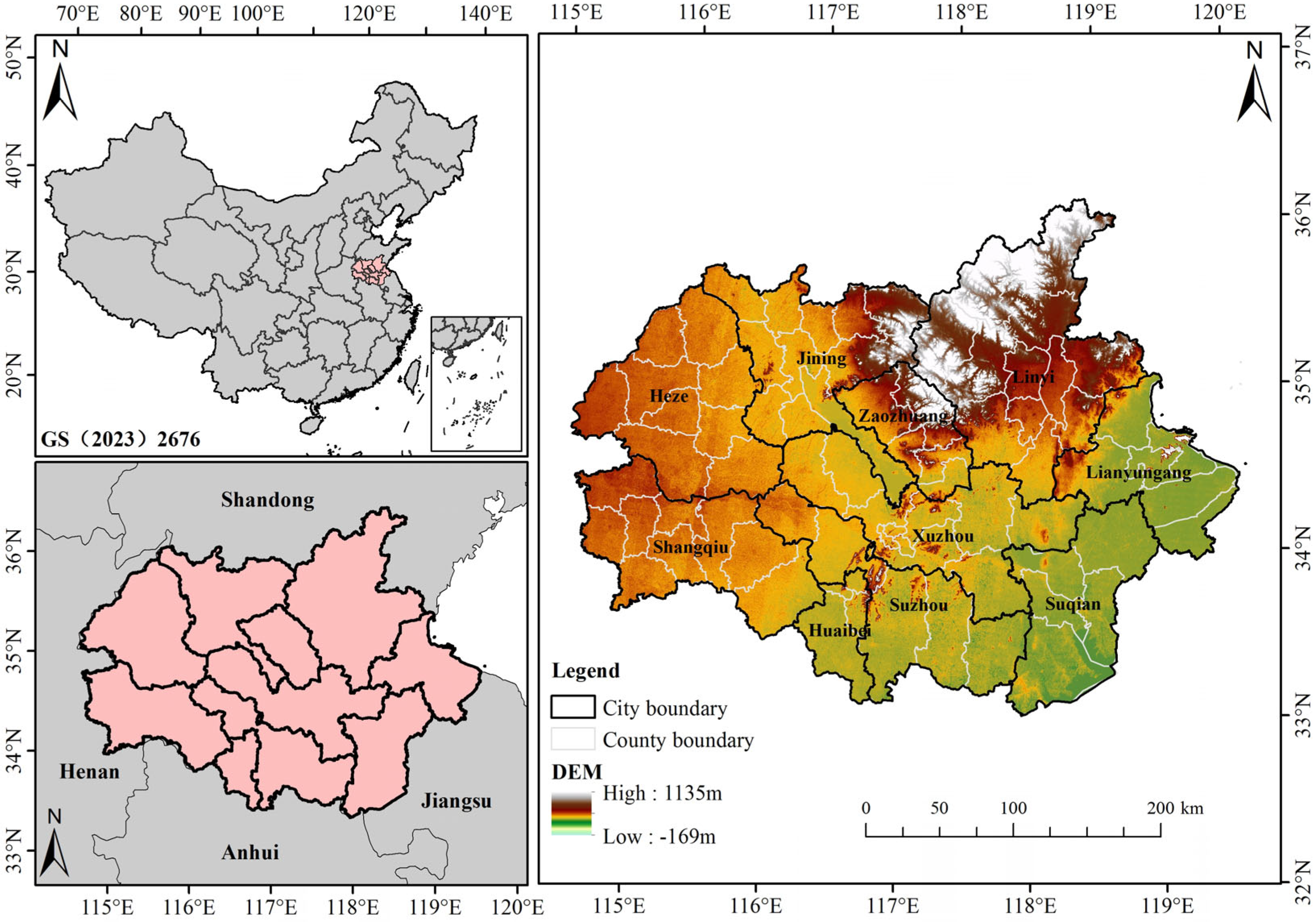
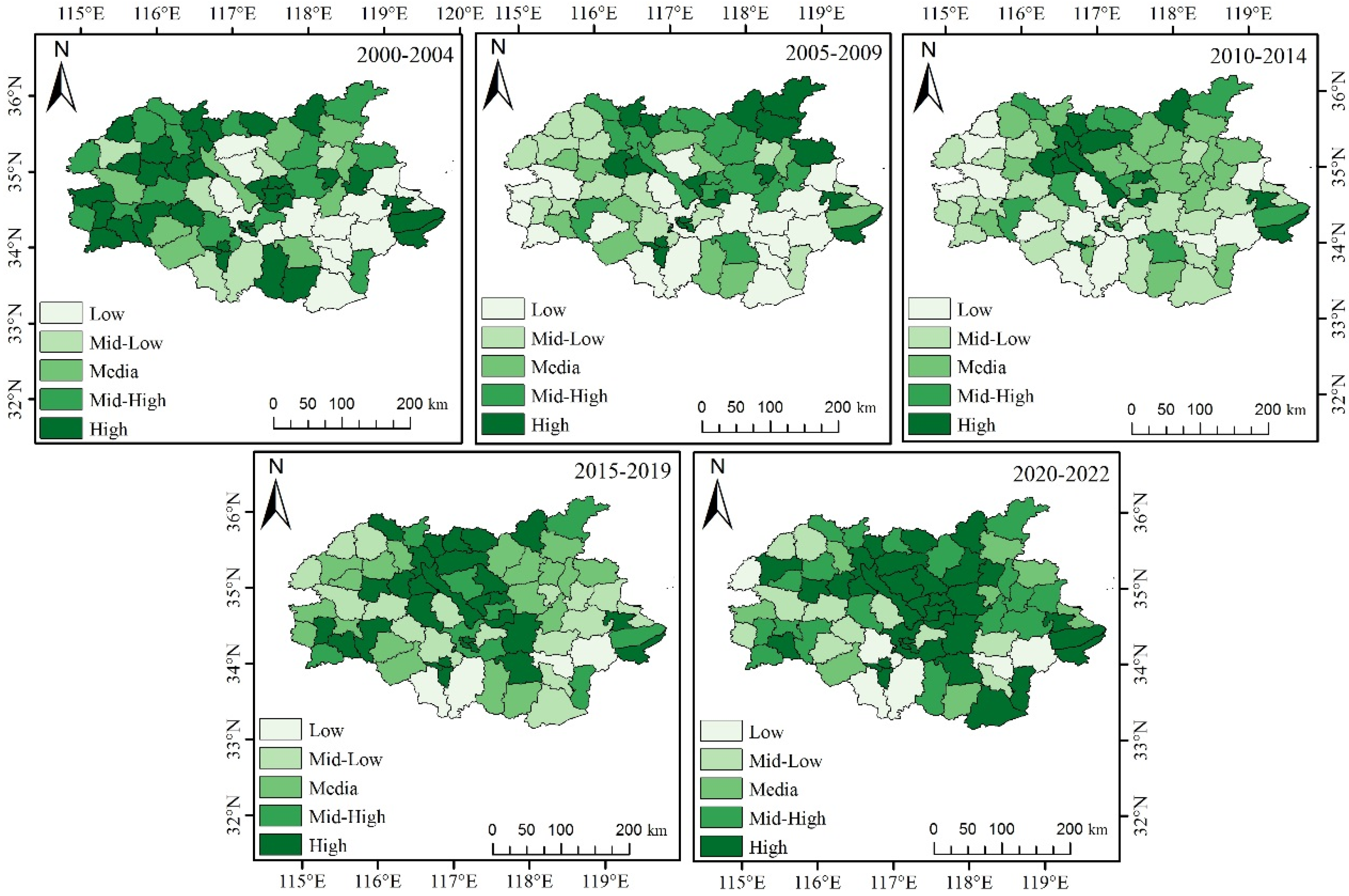
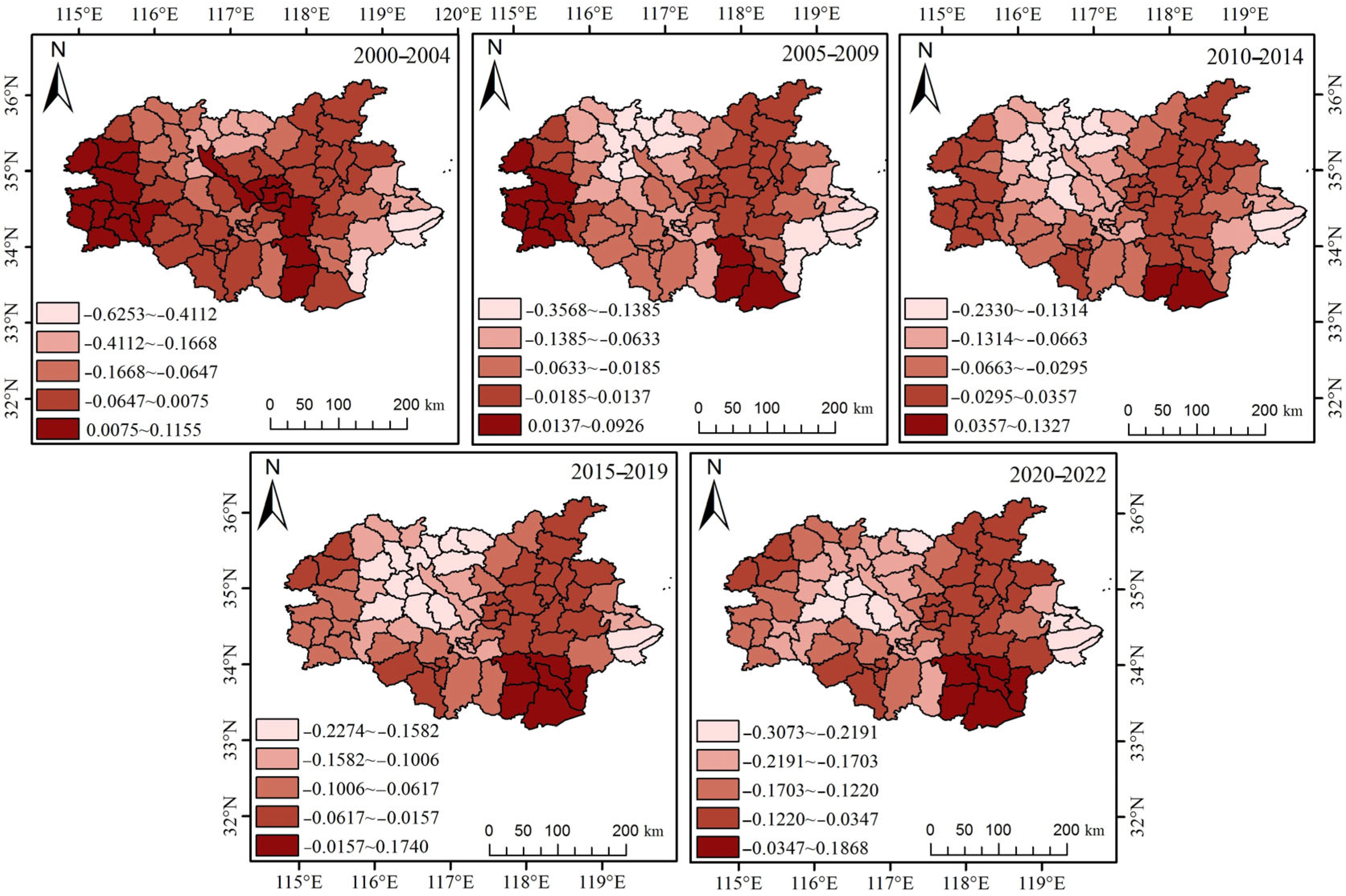

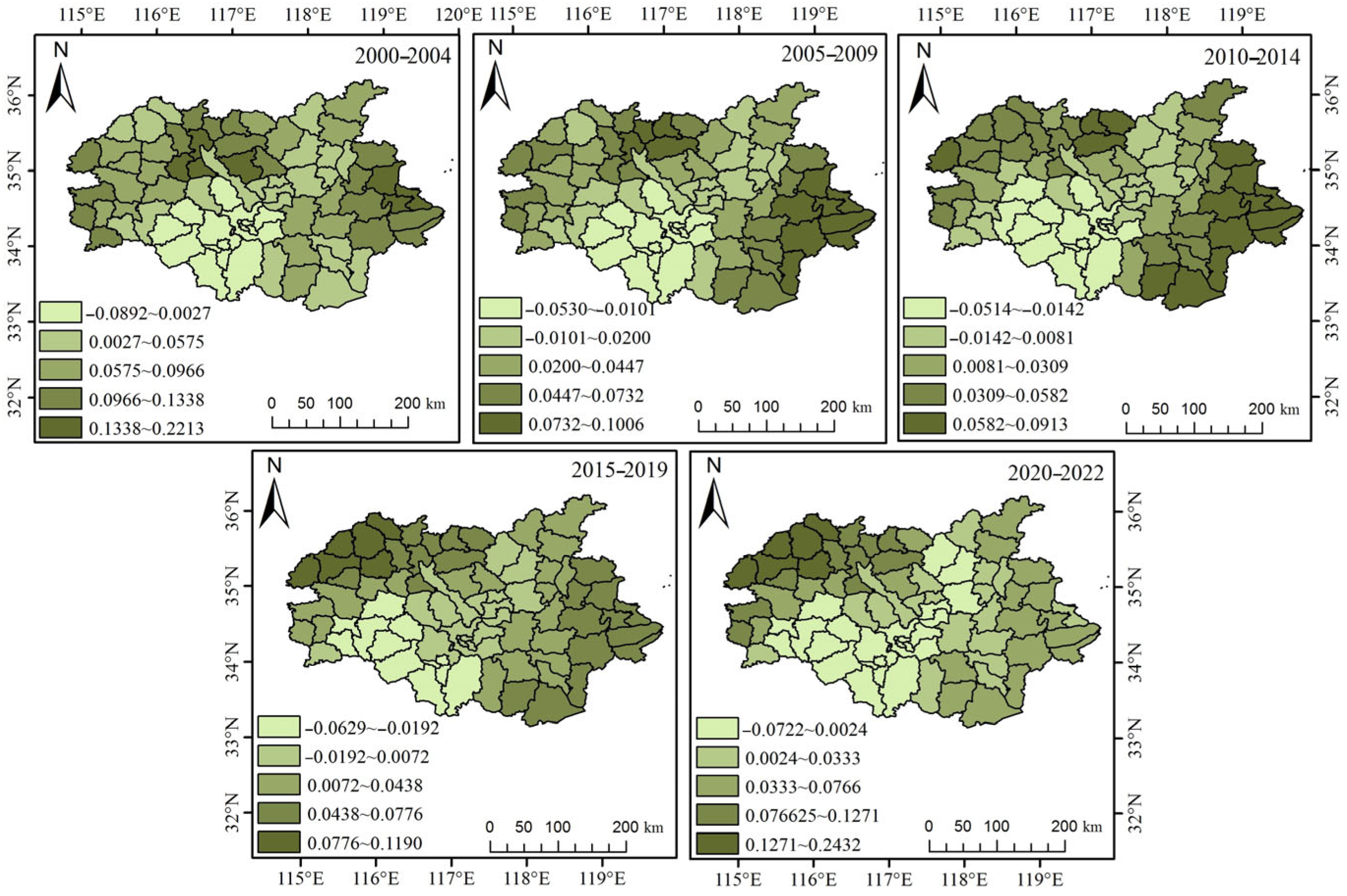

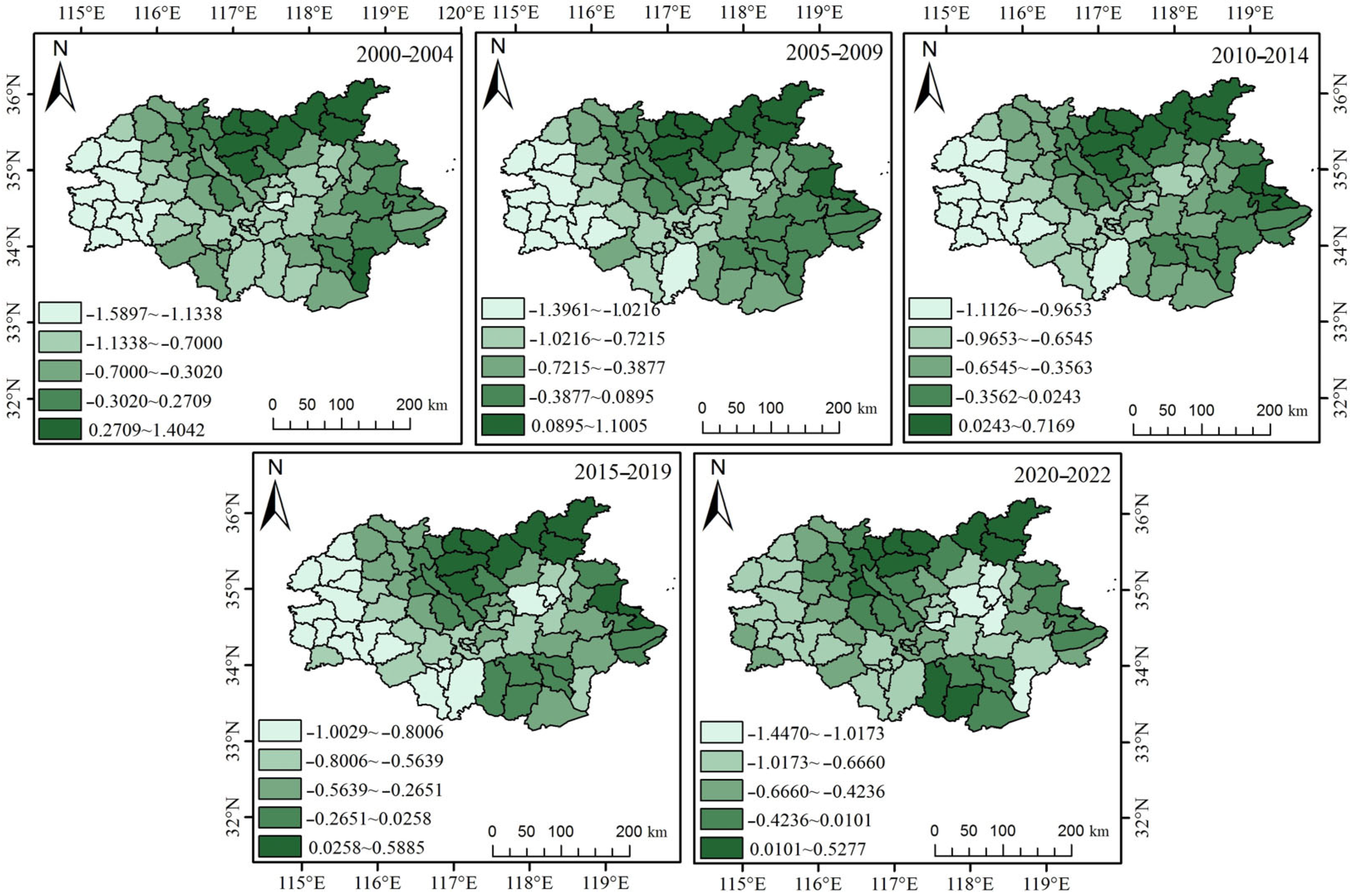
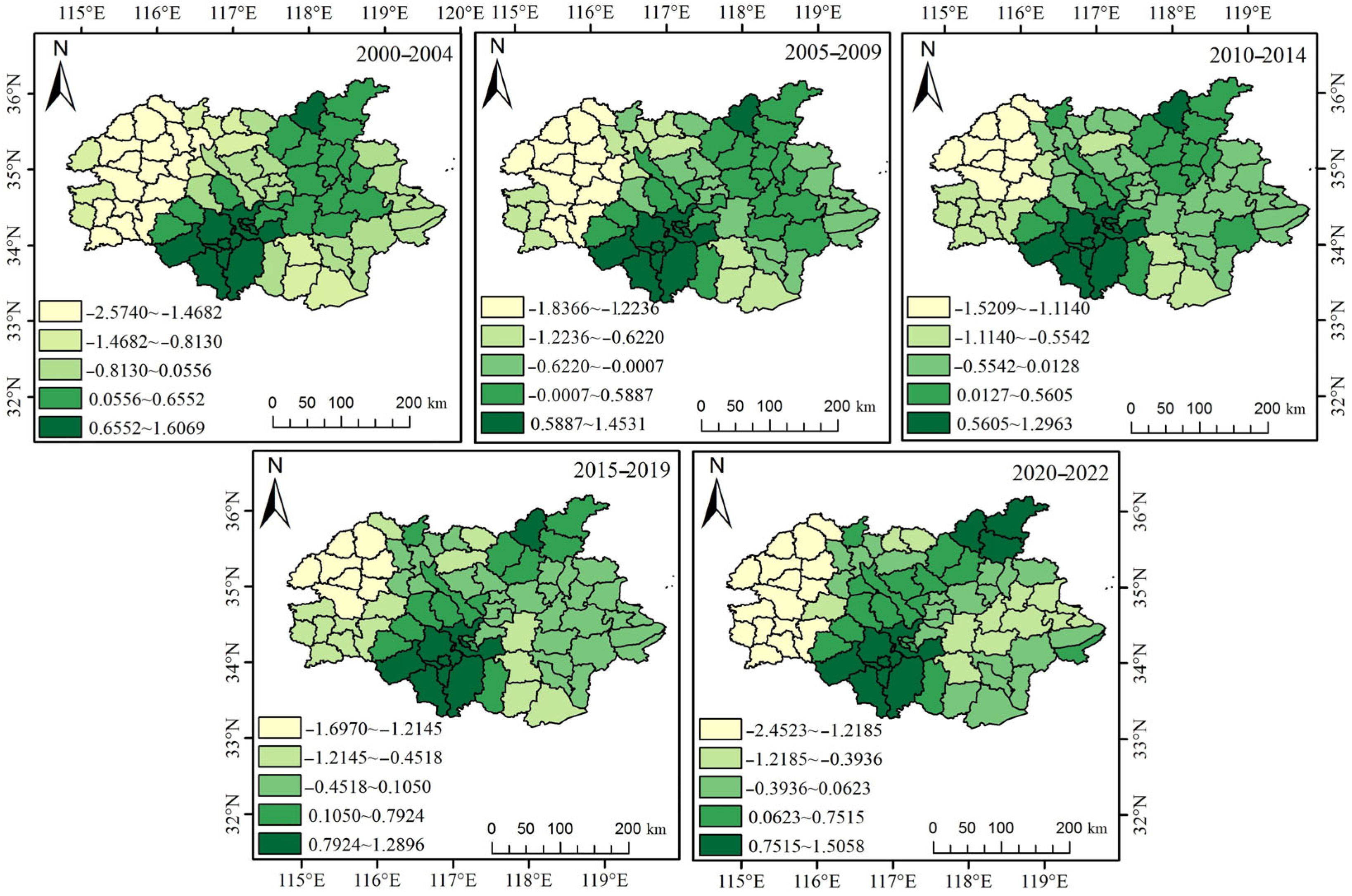
| Category | Description of the Index | Data Source | |
|---|---|---|---|
| Input indicators | Land input | Total area of cultivated land | National Ecological Science Data Center (https://www.nesdc.org.cn/sdo/detail?id=6455d00e7e28173b252d9965, accessed on 14 April 2025) China Land Cover Dataset (CLCD) |
| Total area of construction land | |||
| Resource input | The total radiant pixel value of the nighttime light per unit area of land | National Earth System Science Data Center (https://www.geodata.cn/main/face_scientist?categoryId=&word=%E5%A4%9C%E9%97%B4%E7%81%AF%E5%85%89, accessed on 14 April 2025) | |
| Capital input | Investment in fixed assets per unit area of land | China City Statistical Yearbook/China County Statistical Yearbook/County Statistical Yearbook | |
| Labor input | Year-end employees per unit area of land | ||
| Output indicators | Desirable output | Total GDP per unit area of land | |
| Ecosystem service value per unit area of land | Calculated based on the CLCD and the modified ecosystem service equivalent | ||
| Local fiscal general public budget revenue per unit area of land | China City Statistical Yearbook/China County Statistical Yearbook/County Statistical Yearbook | ||
| Undesirable output | Industrial wastewater discharge per unit area of land | ||
| Industrial sulfur dioxide emissions per unit area of land | |||
| Industrial soot emissions per unit area of land | |||
| Category | Description of the Index | Data Source |
|---|---|---|
| Industrial structure | the added value of the secondary/tertiary industry (X1) | China City Statistical Yearbook/China County Statistical Yearbook/County Statistical Yearbook |
| Technological innovation | the number of publicly published patents (X2) | China National Intellectual Property Administration (https://www.cnipa.gov.cn/module/download/down.jsp?i_ID=197320&colID=88, accessed on 14 April 2025) |
| Urbanization level | the proportion of urban population in the total population (X3) | China City Statistical Yearbook/China County Statistical Yearbook/County Statistical Yearbook |
| regional road density (X4) | Calculated based on Google Maps and OpenStreetMap data | |
| Environmental regulation | environmental pollution control investment (X5) | China City Statistical Yearbook/China County Statistical Yearbook/County Statistical Yearbook |
| Ecological background | RSEI (X6) | Google Earth Engine |
| the green coverage area of built-up areas (X7) | China City Statistical Yearbook/China County Statistical Yearbook/County Statistical Yearbook | |
| Land use | the composite index of land use degree (X8) | National Ecological Science Data Center (https://www.nesdc.org.cn/sdo/detail?id=6455d00e7e28173b252d9965, accessed on 14 April 2025) CLCD |
| the Simpson index of land use structure (X9) |
| 2000–2022 | 2000–2004 | 2005–2009 | 2010–2014 | 2015–2019 | 2020–2022 | |||||||
|---|---|---|---|---|---|---|---|---|---|---|---|---|
| Trends in LUEE | ↑ | ↓ | ↑ | ↓ | ↑ | ↓ | ↑ | ↓ | ↑ | ↓ | ↑ | ↓ |
| Number of counties/ percentage (%) | 49 | 28 | 26 | 52 | 38 | 39 | 48 | 29 | 58 | 19 | 56 | 21 |
| 63.63 | 36.36 | 33.77 | 67.53 | 49.35 | 50.65 | 62.34 | 37.66 | 75.32 | 24.68 | 72.73 | 27.27 | |
| Number of municipal districts or county-level cities/percentage (%) | 42 | 35 | 13 | 22 | 19 | 16 | 19 | 16 | 30 | 5 | 30 | 5 |
| 55.10 | 28.75 | 50.00 | 42.31 | 50.00 | 41.03 | 39.58 | 55.17 | 51.72 | 26.32 | 53.57 | 23.81 | |
| Year | Moran’s I | Z-Value | p-Value |
|---|---|---|---|
| 2000–2004 | 0.1197 | 1.8543 | 0.0400 |
| 2005–2009 | 0.2253 | 3.1984 | 0.0020 |
| 2010–2014 | 0.2707 | 4.0090 | 0.0010 |
| 2015–2019 | 0.1934 | 2.8507 | 0.0090 |
| 2020–2022 | 0.1681 | 2.5808 | 0.0090 |
| Category | Variable | β | SE | p-Value | Tolerance | VIF |
|---|---|---|---|---|---|---|
| Constant | — | — | — | — | — | |
| Industrial structure | X1 | −0.192 | 0.048 | 0.000 | 0.885 | 1.129 |
| Technological innovation | X2 | 0.042 | 0.049 | 0.393 | 0.853 | 1.172 |
| Urbanization level | X3 | 0.227 | 0.056 | 0.000 | 0.650 | 1.538 |
| X4 | 0.116 | 0.058 | 0.047 | 0.611 | 1.636 | |
| Environmental regulation | X5 | −0.168 | 0.057 | 0.003 | 0.634 | 1.576 |
| Ecological background | X6 | −0.220 | 0.047 | 0.000 | 0.931 | 1.074 |
| X7 | −0.004 | 0.056 | 0.937 | 0.656 | 1.524 | |
| Land use | X8 | 0.018 | 0.062 | 0.775 | 0.532 | 1.879 |
| X9 | 0.180 | 0.057 | 0.002 | 0.645 | 1.549 |
| Index | OLS | GWR | GTWR |
|---|---|---|---|
| R2 | 0.227 | 0.624 | 0.718 |
| Adjusted R2 | 0.209 | 0.616 | 0.712 |
| AICc | −116.381 | −207.658 | −200.334 |
| Index | Coordinates of the Government Station-GTWR | GDP Center of Gravity Coordinates-GTWR | Population Center of Gravity Coordinates-GTWR |
|---|---|---|---|
| R2 | 0.718 | 0.733 | 0.721 |
| Adjusted R2 | 0.712 | 0.728 | 0.713 |
| AICc | −200.334 | −235.113 | −268.471 |
Disclaimer/Publisher’s Note: The statements, opinions and data contained in all publications are solely those of the individual author(s) and contributor(s) and not of MDPI and/or the editor(s). MDPI and/or the editor(s) disclaim responsibility for any injury to people or property resulting from any ideas, methods, instructions or products referred to in the content. |
© 2025 by the authors. Licensee MDPI, Basel, Switzerland. This article is an open access article distributed under the terms and conditions of the Creative Commons Attribution (CC BY) license (https://creativecommons.org/licenses/by/4.0/).
Share and Cite
Teng, G.; Chen, L.; Zhang, T.; Li, L.; Xiao, J.; Ma, L. The Spatiotemporal Evolution of Land Use Ecological Efficiency in the Huaihai Economic Zone: Insights from a Multi-Dimensional Framework and Geospatial Modeling. Land 2025, 14, 883. https://doi.org/10.3390/land14040883
Teng G, Chen L, Zhang T, Li L, Xiao J, Ma L. The Spatiotemporal Evolution of Land Use Ecological Efficiency in the Huaihai Economic Zone: Insights from a Multi-Dimensional Framework and Geospatial Modeling. Land. 2025; 14(4):883. https://doi.org/10.3390/land14040883
Chicago/Turabian StyleTeng, Gan, Longqian Chen, Ting Zhang, Long Li, Jue Xiao, and Linyu Ma. 2025. "The Spatiotemporal Evolution of Land Use Ecological Efficiency in the Huaihai Economic Zone: Insights from a Multi-Dimensional Framework and Geospatial Modeling" Land 14, no. 4: 883. https://doi.org/10.3390/land14040883
APA StyleTeng, G., Chen, L., Zhang, T., Li, L., Xiao, J., & Ma, L. (2025). The Spatiotemporal Evolution of Land Use Ecological Efficiency in the Huaihai Economic Zone: Insights from a Multi-Dimensional Framework and Geospatial Modeling. Land, 14(4), 883. https://doi.org/10.3390/land14040883












